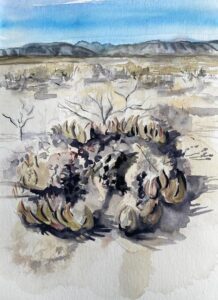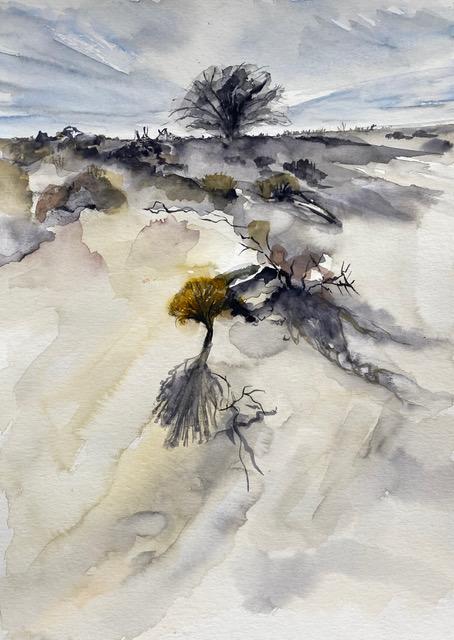Nothing much eats a porcupine. But what a porcupine eats could signal the end of the Laager Aloe, an ancient plant that lives for up to a thousand years in South Africa’s increasingly arid Karoo.
This semi-desert region stretches for about 155,000 square miles (larger than Germany) north and east of Cape Town. It is known for its dramatic landscapes, low rainfall, extreme temperatures, and the distinctive taste of its sheep that eat a small squat plant which smells of menthol.
Outside a town named after Queen Victoria’s consort, Prince Albert, 250 miles north-east of Table Mountain, is a small private nature reserve called Wolwekraal (literally, wolf enclosure). Its owner is Dr Sue Milton-Dean, an ecologist, who works to preserve the Karoo’s highly diverse flora under existential threat from climate change.
Impact
“I never thought much of climate change until I saw its devastating impact here,” she says.
Sue takes visitors on a two-hour guided walk through her reserve which at first sight looks like a bald man’s head after a partially successful hair transplant. Scattered around the rocks, stones and sand are dry, squat bushes; some spikey, others succulent, and many dead. You can understand why the farmer from whom she bought the land thought her somewhat nutty. There’s hardly enough vegetation on its 280 acres to support a few sheep, and the river that runs through it ran dry many years back.
Wolwekraal is part to the Karoo Biome which is made up of three regions — Bushmanland, Upper Karoo and the Lower Karoo, with 13 vegetation units. There are geophytes (bulbs, tubers etc), grasses, herbs and shrubs that have survived and prospered in these sandy, rocky soils for thousands of years.
Sue’s reserve is an example of the Succulent Karoo – a biome of over 6,000 species of plants with around 40 per cent found nowhere else in the world. The rainfall here is less than 200mm a year (and reducing) with temperatures reaching 45 degrees C (and rising).
Arid
Sue explains that dwarf succulents cope with heat and arid conditions by being small and storing water in fat leaves. Their shallow root systems absorb the lightest rain or dew. She shows how they conserve water in many ingenious ways, including growing beneath taller plants and embedding themselves in the soil and covering themselves with UV-reflecting hairs, waxes or scales. Some plants flower at night, protecting their blooms from the fierce heat of the day.
Non-succulents, such as Asparagus, store water and nutrients in their roots whereas others shed their leaves and are dormant after six weeks without rain. When the drought breaks, they regrow their leaves, and flower and seed at any time of year, making the most of the available water.
Ants and termites are the backbone of the ecosystem, providing food for animals who either eat the ants or plunder their stores of nutritious seeds gathered to feed the colonies.
The Karoo, farmed since the European settlers moved north from Cape Town in the 17th century, has supported wild animals (antelope and ostriches) and domesticated herbivores ever since the indigenous people (Khoi and San) lived and roamed there.
Poisons
Plants protect themselves from grazing animals, using tannins, alkaloids or high concentrations of salts to make them unpalatable. Some are poisonous and others thorny, often with tiny spikes near their tips, ensuring that grazing animals can only nip off small amounts of their nourishing leaves. Sue’s rule of thumb: thorny plants are seldom poisonous, but those that look edible could be toxic.
Such natural protection won’t be enough if temperatures continue to rise and ever more frequent droughts persist. Already, dead, grey bushes punctuate the land. These are hardy plants that could no longer cope with the prolonged droughts.
Which brings us back to the porcupine. This extraordinary spiney creature looks like a hedgehog on steroids and is the only animal on Sue’s reserve whose numbers are growing. This is because it has two main food sources. The first is Prince Albert’s rubbish dump nearby that provides nutritious morsels from the town’s tables. The second is the embattled Laager Aloe (Aloe claviflora), a single plant that looks like a group of squat aloes growing in a circle. It gets its name from the South African term for circling the wagons – a laager. Unlike other aloes, its flowers protrude sideways to protect them from the strong, dry winds that blow constantly across the plains.

Laager Aloe lives for up to a thousand years.
The porcupine has developed a deadly line of attack. Aloe leaves are extremely bitter and inedible, so its strips and discards the leaves to expose the Laager Aloe’s tasty, sweet stems. The porcupine eats the stems and in so doing kills the ancient plant, further unbalancing the already unbalanced ecosystem.
Positive
It would be good to identify something positive from the porcupine’s destructive actions. But it is only one of the many pressures brought on by climate change that are severely stressing the Karoo’s ecosystems, as well as the farmers who have survived and prospered in its harsh but unique environment.
We compliment Sue on her work, which includes academic research and a commercial nursery producing local plants, called Renu-Karoo. With a name like that you would think she sees a bright future. But no: “Too little, too late,” she shrugs.
Let’s hope she’s wrong.
